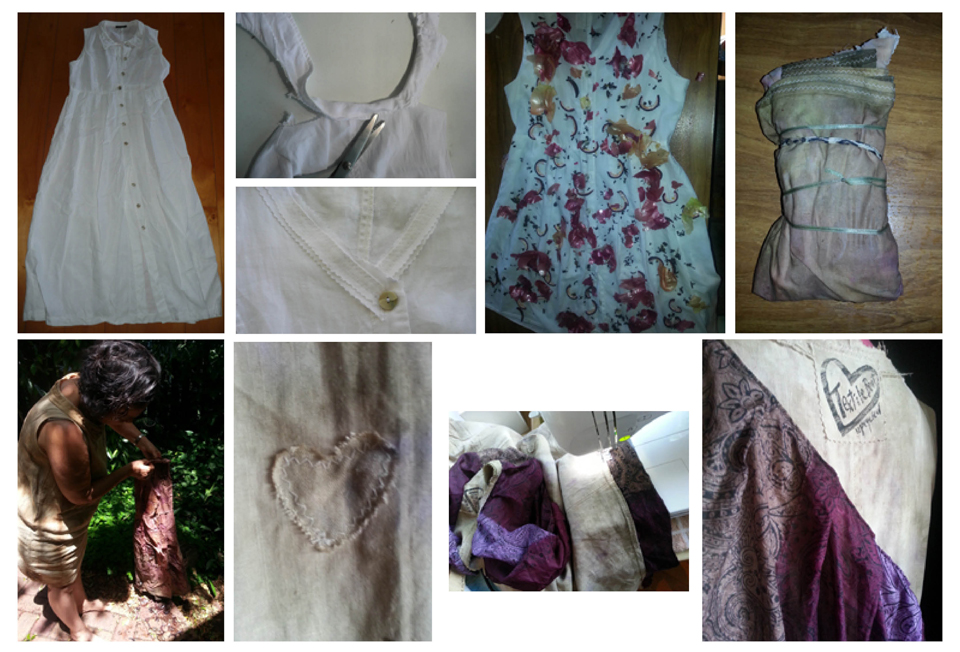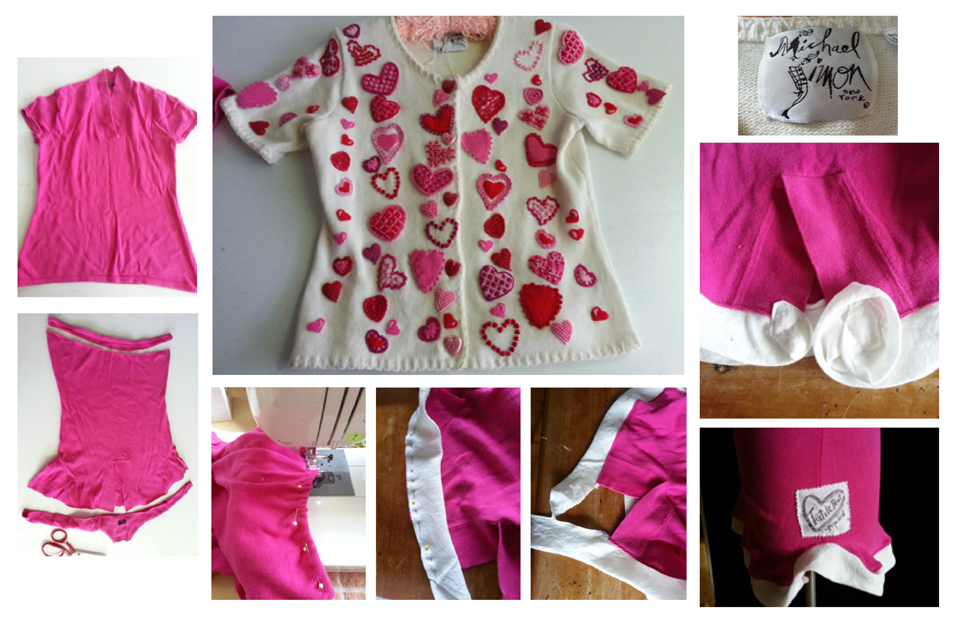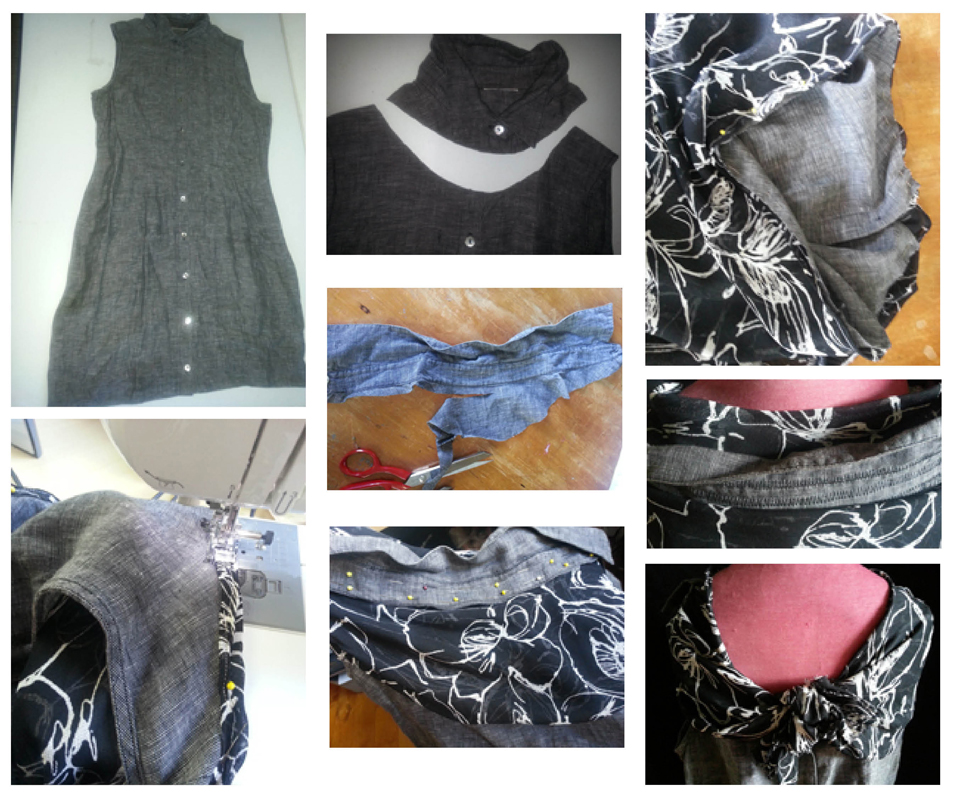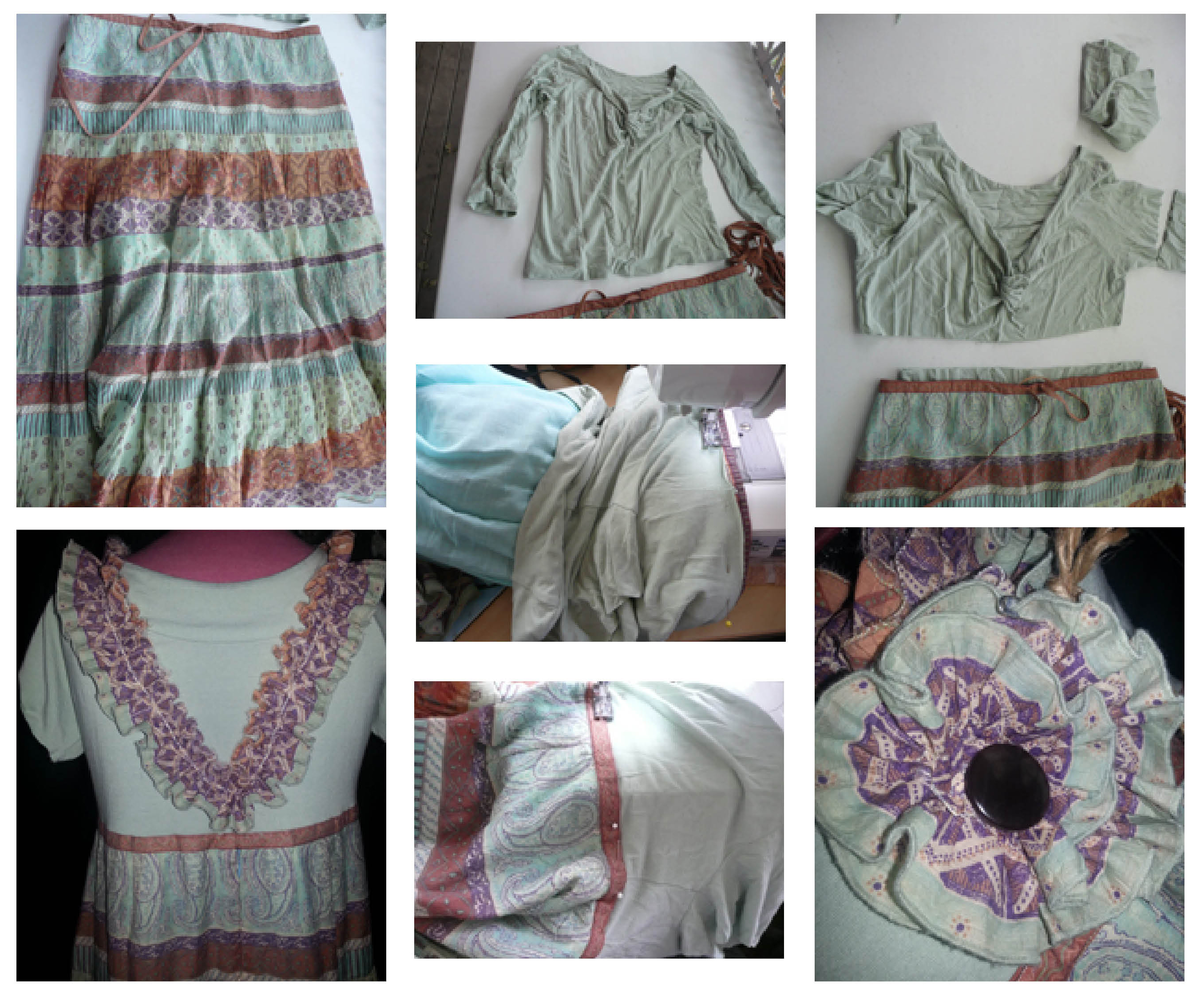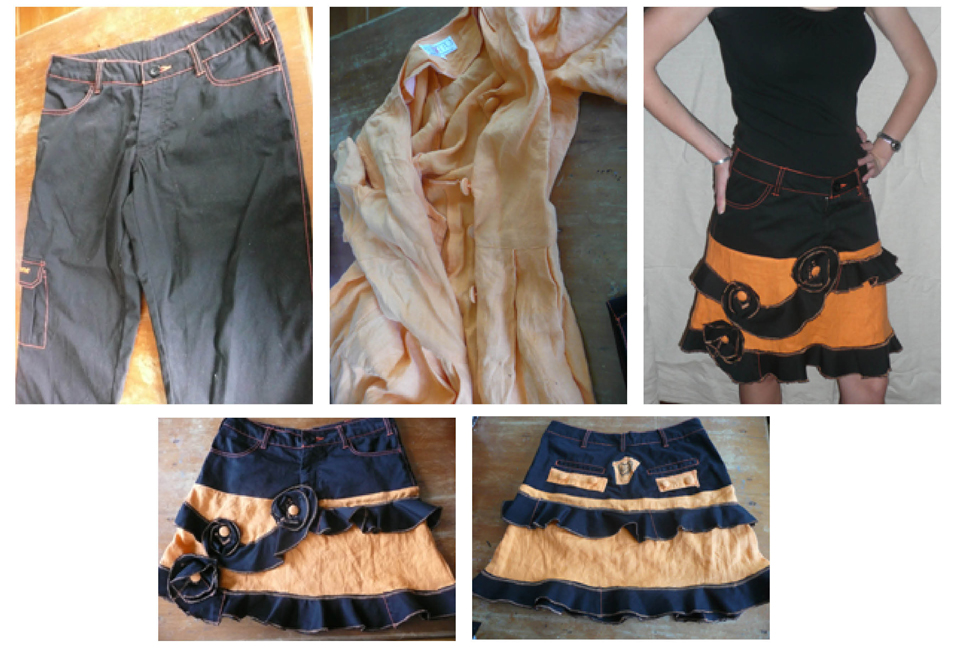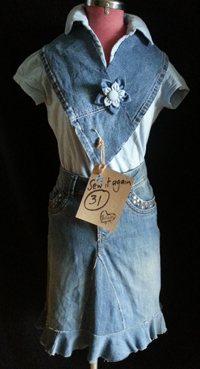 This denim jeans-to-skirt conversion marks the completion of one month’s upcycling in my year-long campaign transforming discarded garments for a second life. Yippee. I’m learning, discovering and connecting with others as I demonstrate choices we have for a different way of dressing that is mindful of ecological health, Earth’s limited resources, wellbeing, ethical sourcing, creativity, thrift, resourcefulness and individual choice. At its heart, this Sew it Again campaign seeks to revive home-sewing as the enabler to wean us from dependence on others for everyday clothing which is as important to our health and wellbeing as the food we eat. Home-cooking has made a comeback, so why not home-sewing? I’m demonstrating ways of resewing existing garments at home as a quick, easy, rewarding and affordable way of dressing because there are mountains of discards stashed away in wardrobes and languishing in op shops. Continue reading
This denim jeans-to-skirt conversion marks the completion of one month’s upcycling in my year-long campaign transforming discarded garments for a second life. Yippee. I’m learning, discovering and connecting with others as I demonstrate choices we have for a different way of dressing that is mindful of ecological health, Earth’s limited resources, wellbeing, ethical sourcing, creativity, thrift, resourcefulness and individual choice. At its heart, this Sew it Again campaign seeks to revive home-sewing as the enabler to wean us from dependence on others for everyday clothing which is as important to our health and wellbeing as the food we eat. Home-cooking has made a comeback, so why not home-sewing? I’m demonstrating ways of resewing existing garments at home as a quick, easy, rewarding and affordable way of dressing because there are mountains of discards stashed away in wardrobes and languishing in op shops. Continue reading
Monthly Archives: January 2014
Sew 30 – Library full of knowledge
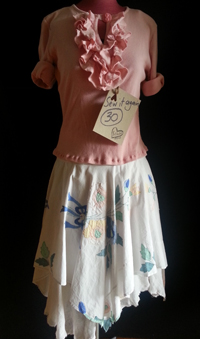 This garment was upcycled by Jane Milburn of Textile Beat. It is part of the Sew it Again project to demonstrate a different way of dressing by repurposing exiting clothing for pleasure, reward and sustainability.
This garment was upcycled by Jane Milburn of Textile Beat. It is part of the Sew it Again project to demonstrate a different way of dressing by repurposing exiting clothing for pleasure, reward and sustainability.
That’s my job this year because I’m stepping up. As Rachael Robertson says in her book Leading on the Edge … ‘if you have the expertise or knowledge, speak out and step up into leadership, regardless of your position’.
The current propensity for endless, almost mindless, consumption means our world is bulging with cast-off clothing which we don’t know what to do with because home-sewing skills are now as rare as hen’s teeth.
Perhaps we are at a turning point. The fashion industry is recognizing the need for change after last year’s Rana Plaza fire in Bangladesh exposed exploitation and a fashion revolution is underway. Continue reading
Sew 29 – Earthy and natural
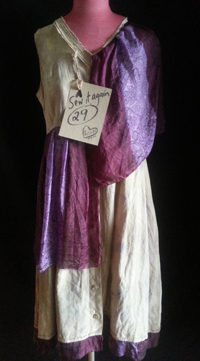 This dress had several makeovers to be what it is today, morphing from long white-collar linen, short no-collar linen, eco-dyed, re eco-dyed, and silk-scarf trimmed.
This dress had several makeovers to be what it is today, morphing from long white-collar linen, short no-collar linen, eco-dyed, re eco-dyed, and silk-scarf trimmed.
All sounds a bit time-consuming, but each stage was a quick change and eventually the garment transformed to be number 29 in my 365-day Sew it Again eco-clothing project.
I’ve bought new the few business suits I own, but the rest of my wardrobe comprises garments I’ve made, altered, salvaged from op shops or been given as cast-off from friends.
I know where my clothes come from, know they are ethically sourced and made of natural fibres (including black cashmere coat Toronto op shop and silk dress Gold Coast op shop).
There’s a growing global awareness about where clothing comes from, how it is produced and its impact on ecological health which mirrors the recent coming to consciousness about food sources and impacts on our own and the planet’s health.
Sustainable apparel consultants such as Shannon Whitehead are bringing awareness to these issues. Shannon summarised in a recent post the six things you should know about your clothes:
- There are chemicals on your clothes
- There are more than 27 million slaves in the world today
- Big retailers are a big problem
- Our old clothes (and disposable behaviour) are ruining Africa’s economy
- It takes decades for your clothing to decompose in a landfill
- We’re not helpless
I began researching this subject while doing leadership study last year which led to my Sew it Again project to demonstrate a different way of dressing by resewing garments from our own and others wardrobes to reuse and repurpose resources that already exist.
Today’s offering had languished in the back of my wardrobe because its button-down front was dated but I love linen and can’t throw it out. I cut the dress to knee-length and cropped off the collar with pinking sheers but found the white was dull (and noticed a small hole which I patched). I used onion and passionfruit skins to dye it – then gave it another burst with passionfruit skins because I loved the purple shades. A silk scarf from a friend complemented the colours so I stitched it on as a drape (and hem trim) to distract from the button-down front. Its earthy and natural – and will be included in Reverse Emporium’s Love Up-Cycled exhibition from February 8.
Sew 28 – Love upcycled
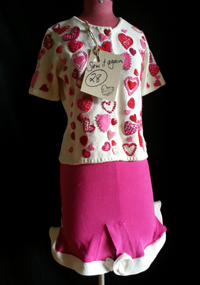 All credit to New York designer Michael Simon for the gorgeous heart features on this vintage top. I just added a few beads to cover age marks and teamed it with a skirt made from an inverted pink top trimmed with cream linen.
All credit to New York designer Michael Simon for the gorgeous heart features on this vintage top. I just added a few beads to cover age marks and teamed it with a skirt made from an inverted pink top trimmed with cream linen.
I’m thrilled to be one of 25 upcyclers contributing to the Love Up-cycled exhibition opening February 8 at the Reverse Emporium which is a great showcase for Sew it Again creations.
This is another small step to establishing the values and brand of Textile Beat as a creative, natural and unique way of dressing that is ethical and sustainable.
Reverse Emporium is at Woolloongabba and runs a quarterly series of exhibitions showcasing the work of Brisbane artists that demonstrate an awareness of sustainable practices and a devotion to reducing the impact of their craft on the environment.
It is the gallery shop front for Reverse Garbage, which says Australians generate about 14 million tonnes of garbage each year. About two-thirds of this is commercial and industrial waste – reuse of which reduces landfill and helps protect the environment from further pollution.
I’m an agricultural scientist by training, a communications consultant by practice and this year I’m on a creative journey upcycling natural fibre garments for pleasure, reward and sustainability.
Hearts are highly relevant for Love Up-cycled with Valentine’s Day just around the corner.
I had to dig deep into my stash to relocate this top gifted to me for upcycling last year by my friend Robyn, which she had been given by a friend 20 years earlier but was no longer wearing.
The quality and integrity of the top is so strong that I resisted the temptation to cut into it. Instead, I teamed it with a mod skirt which I created by turning another top upside down, adding thin elastic at the waistline before trimming it across the sleeves and adding a linen bias-cut frill.
Sew 27 – Resewing brings second life
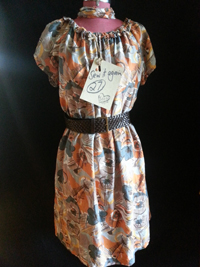 This favourite linen dress was in need of a makeover so I shortened the length, used the off-cut to make a long ribbon then sewed some to the neckline before replacing elastic.
This favourite linen dress was in need of a makeover so I shortened the length, used the off-cut to make a long ribbon then sewed some to the neckline before replacing elastic.
Reinventing clothing that already exists in our own and others wardrobes is my purpose this year as I demonstrate a different way of dressing by resewing existing resources.
In our modern world, home sewing is in danger of becoming a lost art, having fallen off the radar as fast, cheap fashion replaced the need to do for ourselves – just as fast food did with home-cooking.
In the same way that we have rediscovered home-cooking as a nourishing and pleasurable activity, I believe home-sewing is being rediscovered as a life-skill of value and reward. Continue reading
Sew 26 – Australia Day fancy dress
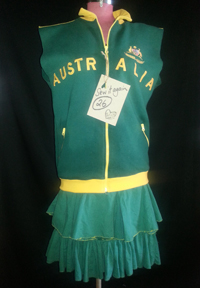 Today’s outfit is a tilt to Australia Day, created using a jacket salvaged from the reject pile when my son Max left home and a skirt from my op-shop stash which is a perfect colour-match.
Today’s outfit is a tilt to Australia Day, created using a jacket salvaged from the reject pile when my son Max left home and a skirt from my op-shop stash which is a perfect colour-match.
This Australia Day, I am proud that champion footballer and anti-racism campaigner Adam Goodes is 2014 Australian of the Year because he is a great story of turning adversity into triumph through integrity, thoughtfulness, and hard work.
And of course, being Australia Day we’re on a countdown to the Triple J Hottest 100 which plays at parties across the nation.
I feel on-trend with my Sew it Again project because it was just two years ago in 2012 that the No 1 song was Michael Macklemore’s Thrift Shop about opportunity shopping and giving pre-loved clothing a second life. Continue reading
Sew 25 – Back to front makeover
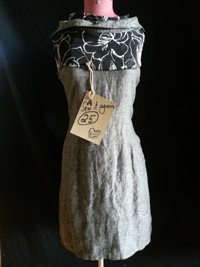 Jazz up a shirtmaker linen dress by turning it back to front, cutting off collar, adding scarf and resewing collar in reverse.
Jazz up a shirtmaker linen dress by turning it back to front, cutting off collar, adding scarf and resewing collar in reverse.
This upcycle marks day 25 of my Sew it Again campaign in which I am on a journey that aligns my values, personal and professional background, skills, instinctive creativity, love of nature and interest in pioneering new opportunities.
It springs from study last year with the Australian Rural Leadership Program in which I identified as a post-conventional leader working at individualist and strategist levels.
According to Rooke and Torbert in Harvard Business Review April 2005, strategists typically have socially conscious business ideas that are carried out in a highly collaborative manner. They seek to weave together idealist visions with pragmatic, timely initiatives and principled actions. Rooke and Torbert’s leadership model outlines a step-wise, logical evolution in leadership capacity built through experience and self-awareness.
Another insight I gained from study was I am an INFP. And thanks to my Twitter friend Lisa Claessen, I was inspired to read via this website that INFP-character traits defined as:
- Introverted: composed, self-reliant, reserved and thoughtful
- Intuitive: creative, imaginative, idealistic and innovative
- Feeling: empathetic, sensitive, ethical and authentic
- Perceiving: flexible, accepting, tolerant and open-minded
Truity says INFPs are imaginative idealists, guided by their own core values and beliefs. They see potential for a better future, and pursue truth and meaning with their own individual flair.
Individualistic and non-judgmental, INFPs enjoy spending time exploring their own ideas and values are creative and often artistic; they enjoy finding new outlets for self-expression.
INFPs value authenticity and want to be original and individual in what they do. They are often concerned with a search for meaning and truth within themselves. Following tradition holds little appeal for the INFP; they prefer to do their own exploration of values and ideas, and decide for themselves what seems right. INFPs are often offbeat and unconventional, but they feel no desire to conform. The INFP would rather be true to themselves than try to fit in with the crowd.
The INFP may react strongly if they feel their own values are being violated, and they want an open, supportive exchange of ideas.
INFPs engage themselves in a lifelong quest for meaning and authenticity. They often have a special affection for the arts, especially the avant garde, as they love experiencing new concepts in self-expression. (Find your type here.)
Well that explains it! For all of the above reasons, I’m spending 2014 on a values-based creative quest to demonstrate a different way of dressing that is sustainable, unique and rewarding.
This shirtmaker dress has intrinsic value for its lovely linen and shell buttons, but the style was dated. I cut off the collar, added a scarf to the neckline leaving the loose ends to tie in a knot at the buttoned back of the dress (which had been the front). I then sewed the collar on the front of the dress (which had been the back). In reality, the dress can be worn either way around – so it now has a second and third life!
Sew 24 – Repurpose skirt to frock
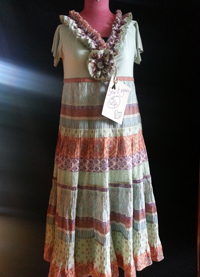 Here’s another long skirt that wasn’t being worn which I’ve turned into a dress by using part of a top which is embellished with a strip torn from the skirt hem.
Here’s another long skirt that wasn’t being worn which I’ve turned into a dress by using part of a top which is embellished with a strip torn from the skirt hem.
At my book club last night with fabulous, feisty, feminist, professional women I’ve been gathering with for more than a decade, I was thrilled to learn several are now dusting off their sewing machines and rediscovering the freedom of sewing.
In her book Sew Retro: a stylish history of the sewing revolution, Judi Ketteler writes about feminist history and women’s role in the home in the nineteenth century when everything was sewn by hand. Then in the twentieth century, women won the right to vote, cut our hair, ditched our corsets and joined the work force in earnest.
Ketteler says sewing was on its way out during the self-indulgent 1980s but is now making a huge comeback, thanks to a third wave of feminism that folded together ideas about DIY creativity, self-reliance, and eco-awareness.
“We don’t need stats to see the role that sewing now plays in so many women’s lives. Women carry their handmade bags to the grocery store, sport ‘upcycled’ denim skirts, and proudly give their handmade creations to friends and family. It’s a long way from 1941, but we’re still ‘sewing for victory’ – a victory over mass-produced, resource-greedy, uninspired, and cheaply made products. “
“We sew to support our families, to release tension from balancing work and family, to clothe the needy, to make a political statement, to celebrate a cancer survivor, to spoil our pets, to save a little money, to make our grandmothers proud, to teach our daughters how to think and live creatively, and just for pure, sweet pleasure.”
When Ketteler wrote this book in 2010, she said “sewing is about empowerment, creativity, sustainability, and sometimes sticking it to The Man. I can’t imagine a better place for sewing to have ended up.”
My Sew it Again project is not just about sewing, it is about re-sewing and demonstrating a different way of dressing. I am repurposing existing garments that have been discarded for various reasons and giving their gorgeous natural fibres a second chance at life.
Today’s offering was a Sportscraft skirt made of pretty printed silk-blend fabric which I merged with part of a stretch knit top to become a frock by sewing them together. The skirt is about 4m circumference at the bottom, and I tore a strip off it to shorten the skirt and provide a gathered feature around the neckline. To tear the strip, you begin with a small cut and then grip your thumb and forefinger close to the edges and tear. It is a satisfying action because you keep moving your hands along the fabric until you get to the other end. I sewed a gathering thread along the middle of this strip, pulled it up and pinned then sewed the strip around the front and back of the top, using the remainder to form a flower feature at the front.
Sew 23 – Upcycle by hand-sew and knots
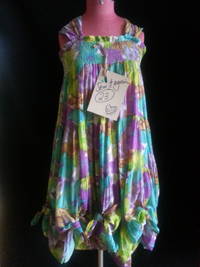 Upcycling can be achieved without a sewing machine as I did by turning this old cotton dress into a muumuu, hand-sewing shoulder straps and knotting the hemline to create interest.
Upcycling can be achieved without a sewing machine as I did by turning this old cotton dress into a muumuu, hand-sewing shoulder straps and knotting the hemline to create interest.
It is empowering to take any old garment and recreate it into something more wearable – and I’m fascinated to be reading and researching others doing this around the world, including the Centre for Sustainable Fashion in London.
By actions and choices, we as individuals can make changes to reduce the burgeoning rate of textile consumption which has been increasing three times faster than the population.
Much of this increased textile use is man-made fibres created using petroleum, coal and gas – which feeds into the whole consumption and disposal issues associated with fast-fashion trends.
NASA reported this week that high temperatures last year were part of a sustained long-term climate warming trend and in Australia, where I live, 2013 was the hottest on record. Continue reading
Sew 22 – Repurposed trousers to skirt
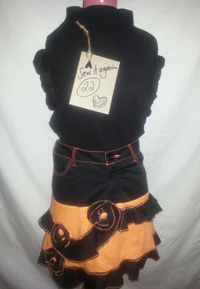 This was a pair of reject promo trousers that I converted to a skirt by adding an A-line extension from an orange dress which I decorated with circular frills cut from the trouser legs.
This was a pair of reject promo trousers that I converted to a skirt by adding an A-line extension from an orange dress which I decorated with circular frills cut from the trouser legs.
Everyone I know has excess garments in their wardrobes. The world is awash with clothing that is no longer fit for purpose, so it makes sense that instead of dumping it in landfill we convert it into something else.
It is disconcerting to read that Australians have the largest homes in the world – after the United States and Canada – and I’m sure this equates to having the biggest wardrobes too!
According to Lindsay Wilson from Shrink that Footprint, the average new home in Australia is 214 m2, the US 201 and Canada 181 m2. The countries with the smallest homes are Hong Kong 45, Russia 57, the United Kingdom 76 and Italy with 81 m2.
I live in a big old Queenslander in Brisbane and I’m mindful that our family has accumulated a lot of stuff over the years. In our defence, most of it is pre-loved treasure, gathered from relatives, flea markets, op shops or friends cast-offs – and a lot of found stuff from nature including rocks, driftwood and shells.
On my 365-day upcycling journey this year, I’m working my way through the wardrobes of natural fibre garments I’ve gathered from ops shops and other sources in recent years.
Today’s upcycle was black cotton trousers from the $2 rack at an op shop, which was branded with advertising but appeared new. I cut them off below the zip and added new front and back panels cut from an orange dress to extend the skirt to above-knee. I cut open the leg off-cuts and used a circle pattern (sorry forgot to photograph this) to cut lengths of frill which I then sewed around the skirt. I made flowers from the leftover bits and sewed salvaged buttons at each centre. The top was one I made years ago with the sleeves rolled up.
